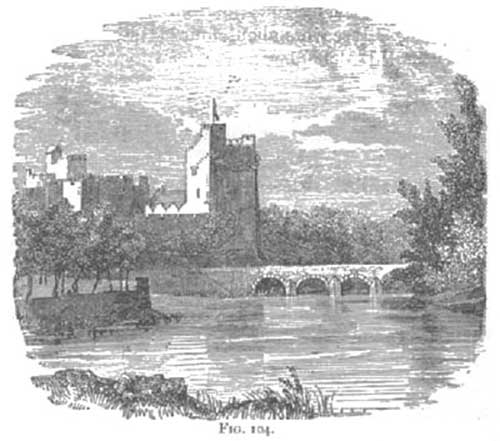Kincora, Bruree, Knockgraffon
From A Smaller Social History of Ancient Ireland 1906
« previous page | contents | start of chapter | next chapter »
CHAPTER XVI....concluded
Kincora.—But when Brian Boru ascended the throne, he came to live at Kincora, where the remains of the palace have all disappeared, inasmuch as the site is now occupied by the town of Killaloe. The O'Briens, as kings of Thomond, continued to reside at Kincora for two centuries after the Battle of Clontarf: but about 1214 they removed their residence to Clonroad near Ennis. One of the outlying forts, a very fine one, still remains, however, beside the Shannon, a mile north of Killaloe, and is now known by the name of Beal Boru.
FIG. 104. Caher Castle: on the site of the old palace. (From Mrs. Hall's Ireland).
Caher.—Another of the Munster palaces, was on a little rocky island in the river Suir at the town of Caher in Tipperary. It was originally called dún-iasgach [eesga], the 'fish-abounding dún,' from the earthen dún that constituted the original fortress-palace. This was succeeded by a circular stone caher, which gave the place its present name. The castle was built by the Anglo-Normans on the site of the caher.
Still another of these Munster palaces was Dun-gclaire [Doonglara], the fort of which is still in good preservation, standing at the northern base of the mountain of Slievereagh near Kilfinnane, two miles nearly north-west from Ballylanders, on the left of the road as you go from this village to Knocklong. It covers about four statute acres, and is now called Doonglara, or more often Lis-Doon-glara.
Brugh-righ.—Bruree in the county Limerick, situated beside the river Maigue, was from remote times one of the seats of the kings of South Munster, as its Irish name Brugh-righ indicates, signifying the 'House of Kings.' The illustrious King Ailill Olom, ancestor of many of the chief Munster families, lived there in the second century: and it continued to be occupied by the Munster kings till long after the Anglo-Norman invasion. The Anglo-Norman chiefs also adopted it as a place of residence, as they did many others of the old Irish kingly seats: and the ruins of two of their fine castles remain. There are still to be seen, along the river, several of the old circular forts, the most interesting of which is the one now universally known in the neighbourhood by the name of Liss-oleem, inasmuch as it preserves the very name of King Ailill Olom, whose timber house was situated within its enclosure. It is situated on the western bank of the river, a mile below the village, in the townland of Lower Lotteragh, in the angle formed by the Maigue and a little stream joining it from the west. It is a circular fort with three ramparts, having the reputation—like most other raths—of being haunted by fairies: and, as it is very lonely and much overgrown with bushes, it is as fit a home for fairies as could well be imagined.
This king's name, Ailill Olom, signifies 'Ailill Bare-Ear,' so called because one of his ears was cut off in a struggle. Olom is accented on the second syllable, and is compounded of o, 'an ear,' and lom, 'bare': in the name "Ailill Olom" it is in the nominative case: "Ailill Bare-Ear" (not "of the Bare-Ear"): like the English names William Longsword, Richard Strongbow. But when placed after "Lis," it takes—as it should take—the genitive form, "Oluim ": and "Lis-Oluim," which is exactly represented in sound by "Lissoleem," signifies 'Olom's lis or residence.' Many examples of the preservation of very old personal and other names in our existing topographical nomenclature are given in my "Irish Names of Places"; and this case of Lissoleem—which has not been noticed before—is fully as interesting as any of them.
Temair-Luachra.—In the time of the Red Branch Knights and of the Munster Degads (p. 42, above), and from immemorial ages previously, the chief royal residence of South Munster was Teamair- or Tara-Luachra, the fort of which in all probability still exists, though it has not been identified. Mr. W. M. Hennessy, in his Introduction to the Mesca Ulad, has brought together the several notices bearing on its position. It was well known in the time of Elizabeth; and anyone acquainted with the country, who would take the trouble to walk over the exact locality indicated, and make inquiry among the old people, would be able, as I believe, to light on and identify the very fort.
Knockgraffon.—Another noted Munster palace was Cnoc-Rafonn, now called Knockgraffon, three miles north of Caher in Tipperary, where the great mound, 60 or 70 feet high, still remains, with the ruins of an English castle beside it. Here resided, in the third century, Fiacha Muillethan [Feeha-Mullehan], king of Munster, who, when the great King Cormac mac Art invaded Munster in an attempt to levy tribute, defeated him at Knocklong and routed his army: an event which forms the subject of the historical tale called "The Siege of Knocklong."
The fort is now as noted for fairies as it was in times of old for royalty: and one of the best known modern fairy stories in connexion with it will be found in Crofton Croker's "Fairy Legends of Ireland" namely, "The Legend of Knockgrafton." This Irish legend has been turned into English verse, but with much interpolation, by Thomas Parnell in his ballad, "A Fairy Tale."
END OF CHAPTER XVI.
« previous page | contents | start of chapter | next chapter »

